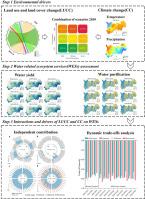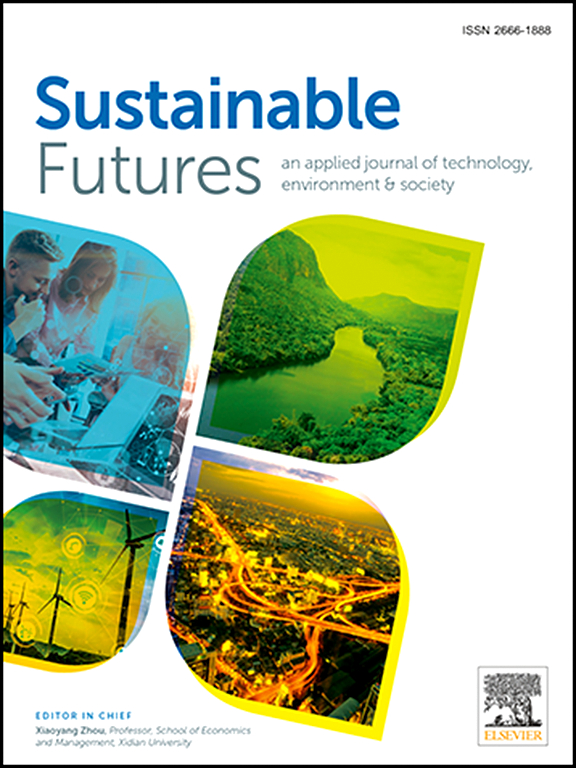Assessing the impacts of multi-scenario climate and land use change on water-related ecosystem services: the case of the Yangtze River Economic Belt (2000–2030)
IF 4.9
2区 社会学
Q2 ENVIRONMENTAL SCIENCES
引用次数: 0
Abstract
Water-related ecosystem services (WESs) are essential for sustainable development, particularly in regions experiencing rapid land use and cover change (LUCC) and climate change (CC). This study evaluates the spatial and temporal impacts, independent contributions, and trade-offs of LUCC and CC on WESs in the Yangtze River Economic Belt (YREB) from 2000 to 2030. By integrating the BCC-CSM2-MR, InVEST, and PLUS models with dynamic trade-offs analysis, our findings indicate that water yield (WY) could increase by up to 53.65 % under the SSP585 climate with cropland protection scenario (CP585), and the upstream surge is significant. Additionally, water purification (WP) is projected to improve across the region, as evidenced by a 10.31 % reduction in phosphorus (P) export under SSP585 climate with ecological protection scenario (EP585), while upstream degrades in the urban expansion (UE) and CP scenarios. CC exerts a predominant positive influence (over 90 %) on WY, while LUCC significantly affect WP especially in the downstream. Overall dynamic trade-offs reveal lowest upstream and highest downstream trade-offs between WESs. Meanwhile the spatial synergy between WESs is expected to be most extensive under the SSP245 climate and EP scenario (EP245). These findings underscore the importance of integrated land and water management strategies to optimize WESs and support sustainable regional development amid future environmental changes. However, this study is limited by its use of annual average precipitation, which ignores seasonal dynamics, and by focusing on the separate effects of LUCC and CC without considering their combined effects. Future research should address these gaps.

多情景气候和土地利用变化对水生态系统服务的影响评估——以长江经济带2000-2030年为例
与水相关的生态系统服务(WESs)对于可持续发展至关重要,特别是在经历快速土地利用和覆盖变化(LUCC)和气候变化(CC)的地区。本研究评估了2000 - 2030年长江经济带土地利用/土地覆盖变化与气候变化对WESs的时空影响、独立贡献和权衡。通过对BCC-CSM2-MR、InVEST和PLUS模型进行动态权衡分析,研究结果表明,在SSP585气候和耕地保护情景(CP585)下,流域产水量(WY)最高可增加53.65%,且上游大幅增加。此外,在SSP585气候和生态保护情景(EP585)下,该地区的水净化(WP)预计将得到改善,磷(P)出口减少10.31%,而在城市扩张(UE)和CP情景下,上游水质下降。CC对WY的正向影响占主导地位(超过90%),而LUCC对WP的正向影响显著,尤其是在下游。整体动态权衡揭示了WESs之间最低的上游和最高的下游权衡。在SSP245气候和EP情景(EP245)下,WESs的空间协同效应最为广泛。这些发现强调了土地和水资源综合管理战略对于优化WESs和在未来环境变化中支持可持续区域发展的重要性。然而,本研究的局限性在于使用了年平均降水量,忽略了季节动态,并且只关注土地利用/土地覆盖变化和气候变化的单独影响,而没有考虑它们的综合影响。未来的研究应该解决这些差距。
本文章由计算机程序翻译,如有差异,请以英文原文为准。
求助全文
约1分钟内获得全文
求助全文
来源期刊

Sustainable Futures
Social Sciences-Sociology and Political Science
CiteScore
9.30
自引率
1.80%
发文量
34
审稿时长
71 days
期刊介绍:
Sustainable Futures: is a journal focused on the intersection of sustainability, environment and technology from various disciplines in social sciences, and their larger implications for corporation, government, education institutions, regions and society both at present and in the future. It provides an advanced platform for studies related to sustainability and sustainable development in society, economics, environment, and culture. The scope of the journal is broad and encourages interdisciplinary research, as well as welcoming theoretical and practical research from all methodological approaches.
 求助内容:
求助内容: 应助结果提醒方式:
应助结果提醒方式:


